A CO2-Driven Gas Lift Mechanism in Geyser Cycling (Uzon Caldera, Kamchatka)
Abstract
1. Introduction
2. Geological Setting
3. Gas-Chemistry Composition and Interval Between Eruption (IBE) History of the Shaman Geyser
4. Bottom-Hole Temperature Tests and Sampling of Shaman Geyser in 2019
5. Conceptual Model of Geyser Shaman Cycling
6. TOUGH2-EOS2 Modeling of Shaman Cycling Conditions
6.1. Model Setup
6.2. Modeling Results
6.2.1. Steady-State Mode
6.2.2. Geyser Cycling Mode
6.2.3. Cycling Flowrate Mode
7. Discussion and Conclusions
Author Contributions
Funding
Acknowledgments
Conflicts of Interest
Appendix A

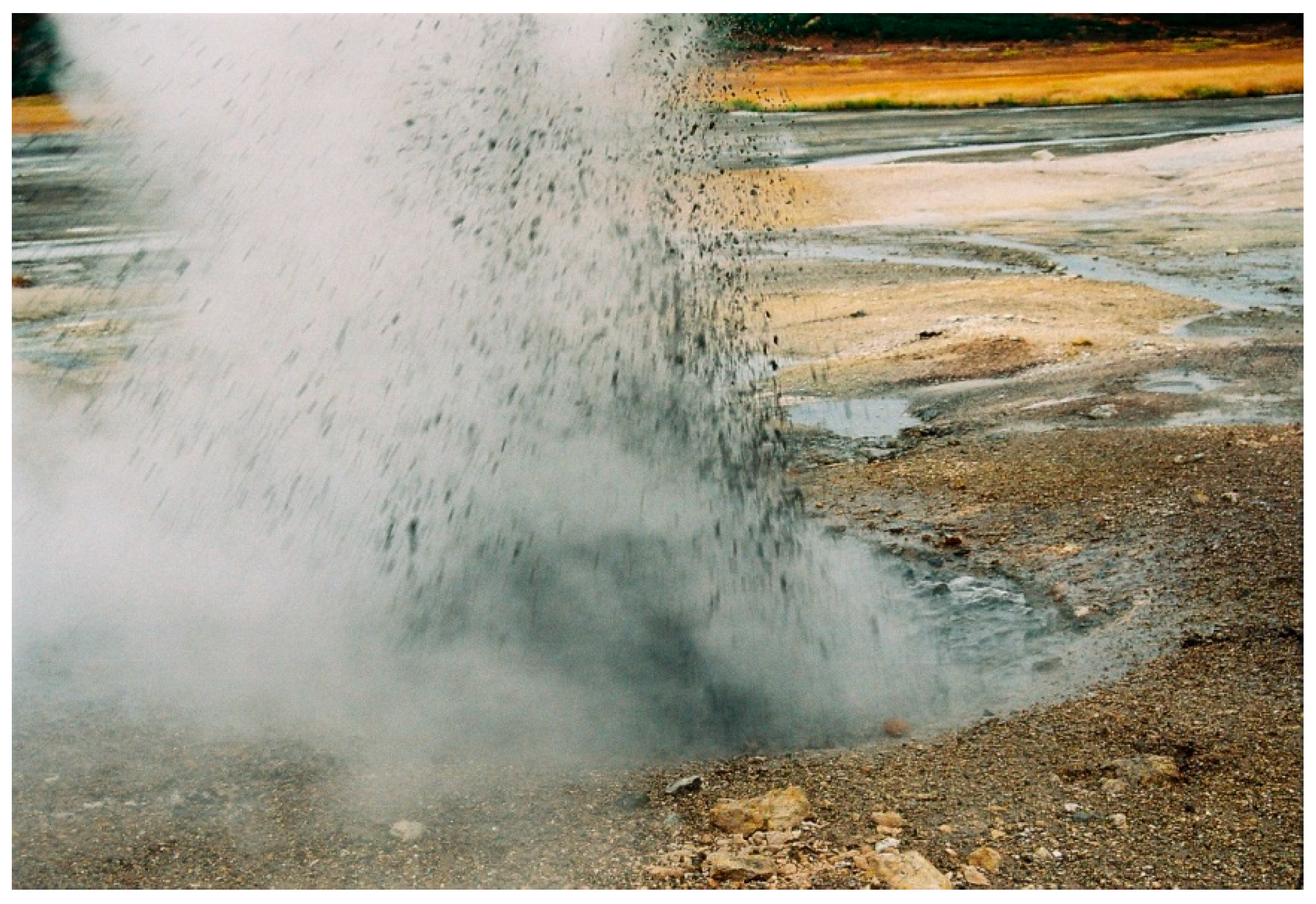
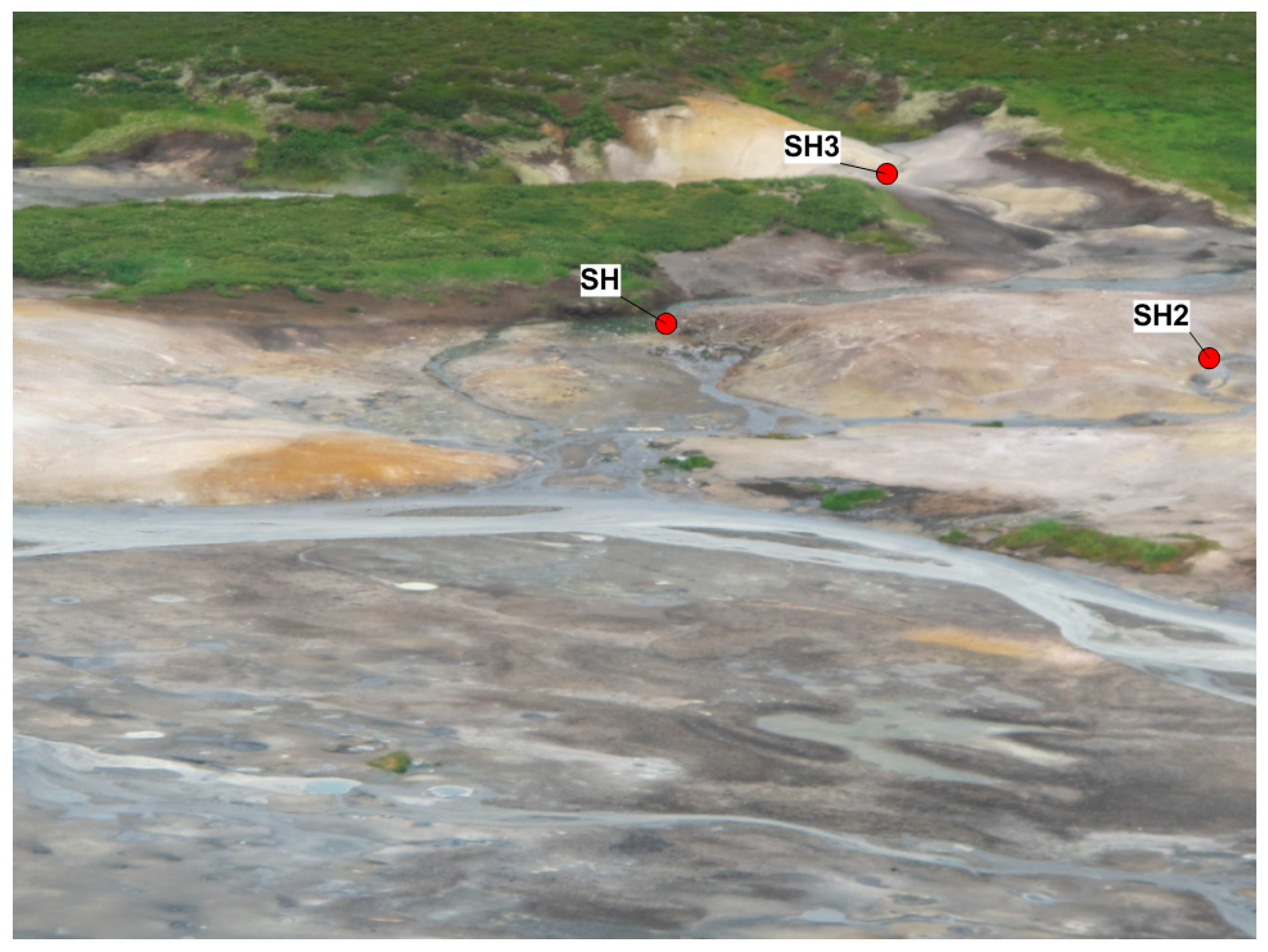
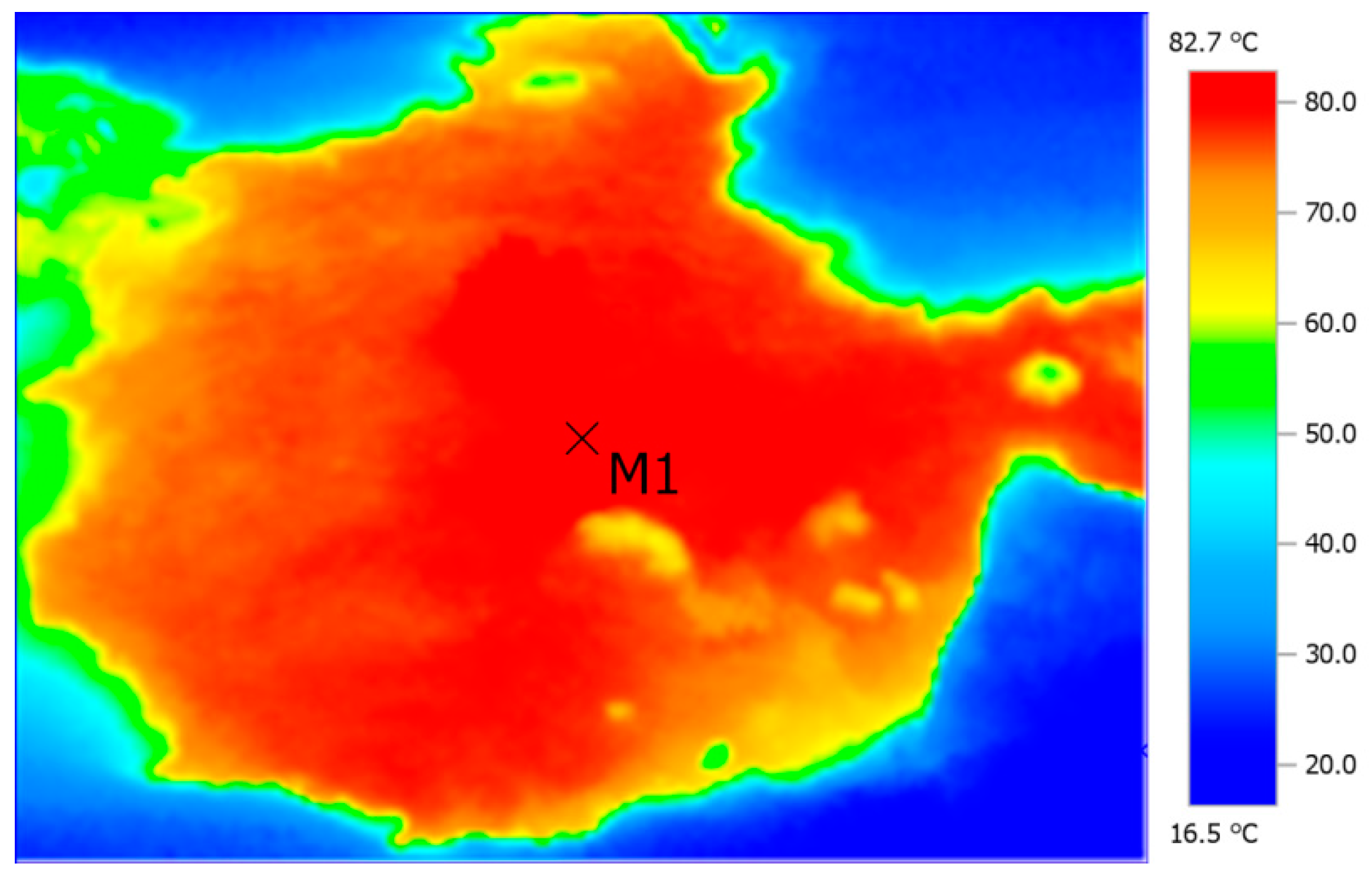



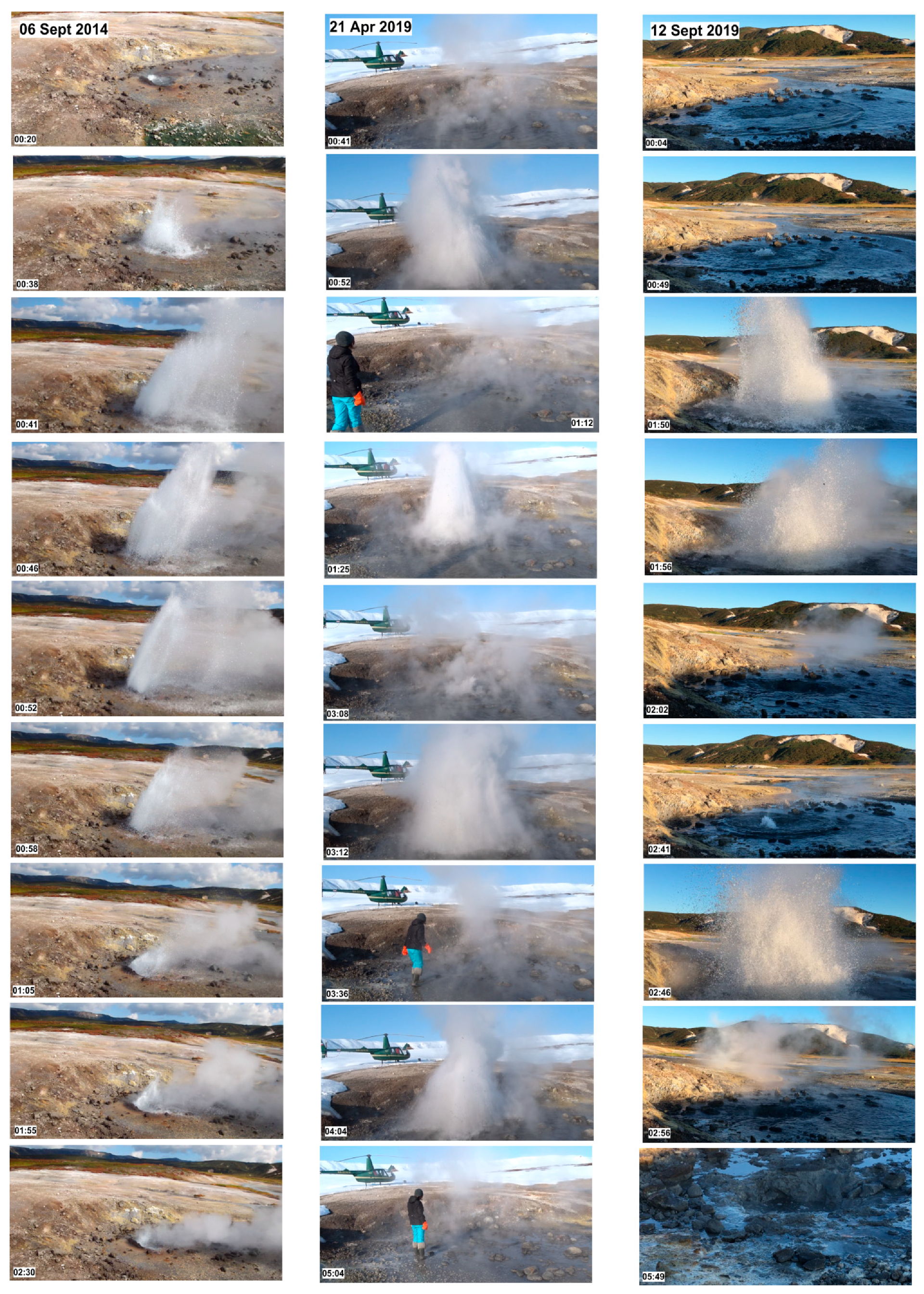
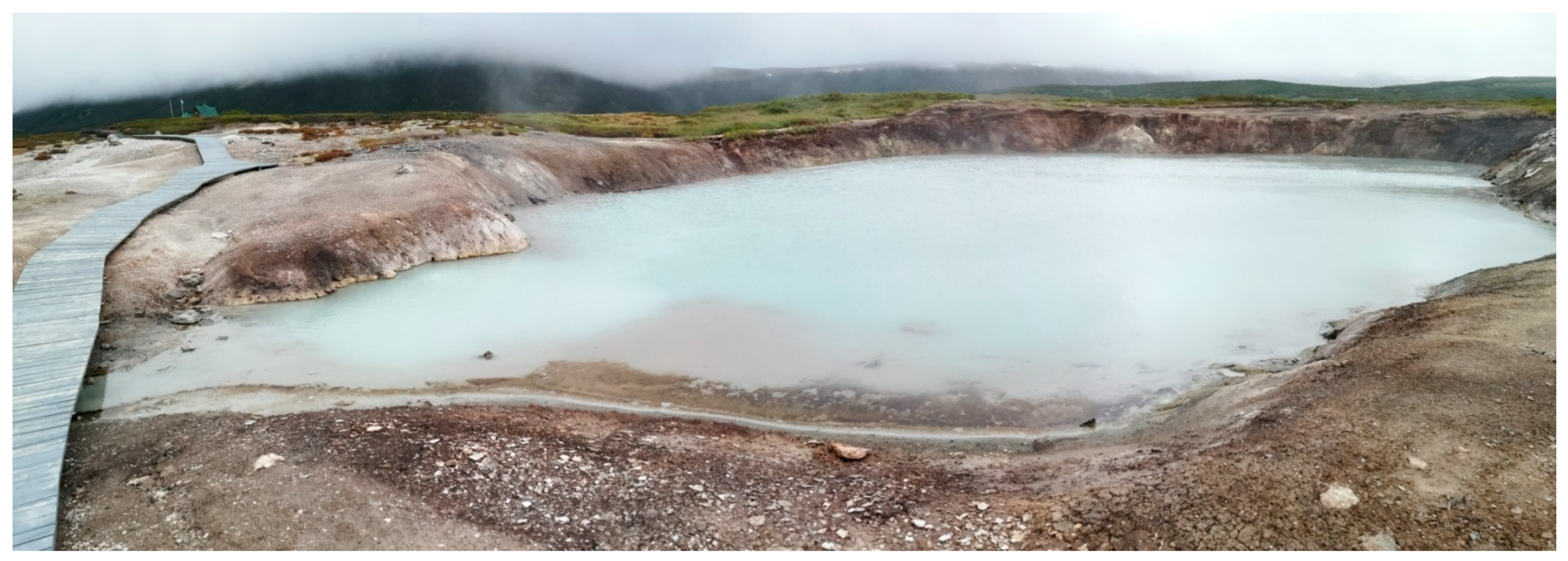

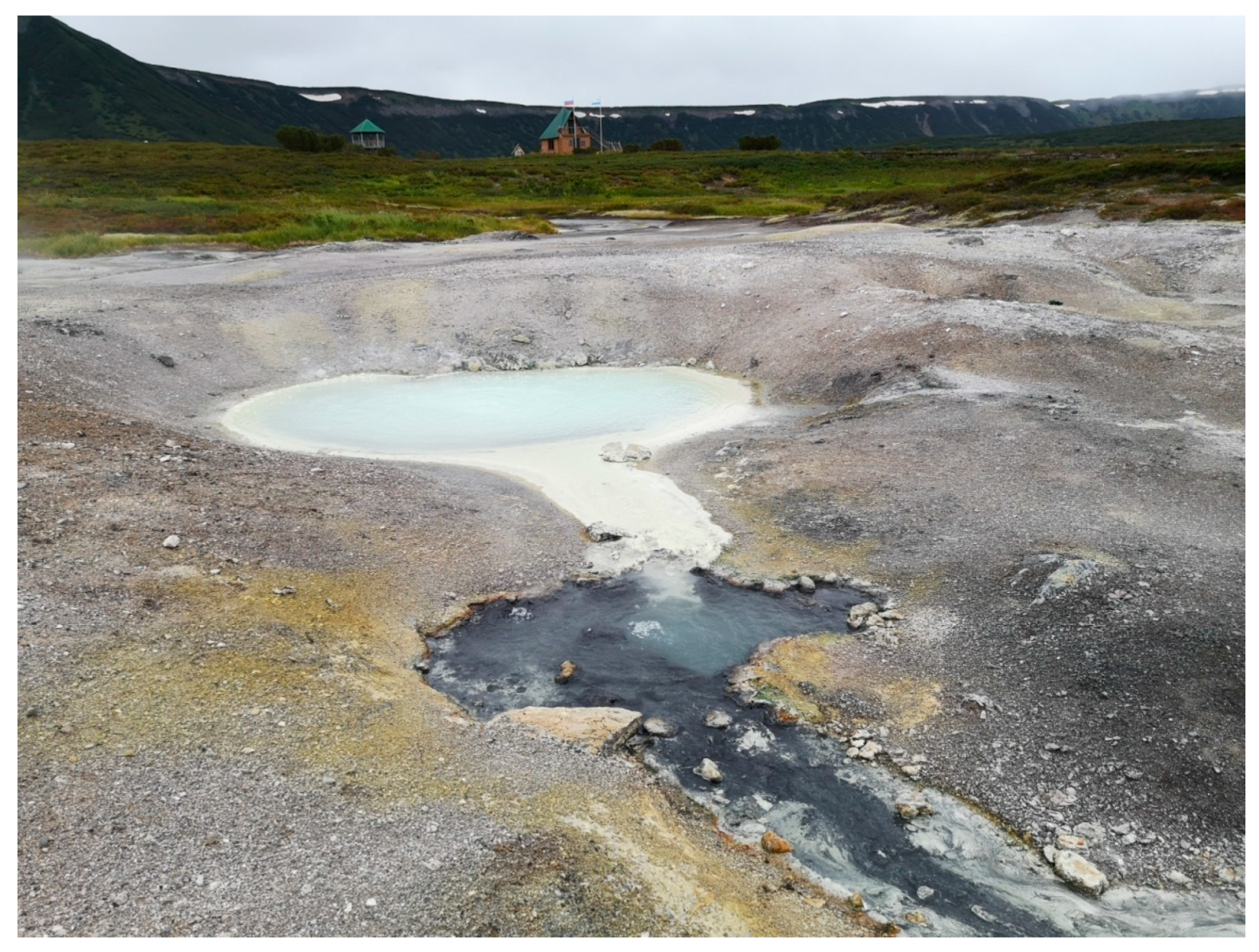
References
- Hurwitz, S.; Manga, M. The fascinating and complex dynamics of geyser eruptions. Annu. Rev. Earth Planet. Sci. 2017, 45, 31–59. [Google Scholar] [CrossRef]
- Hurwitz, S.; Clor, L.E.; McCleskey, R.B.; Nordstrom, D.K.; Hunt, A.G.; Evans, W.C. Dissolved gases in hydrothermal (phreatic) and geyser eruptions at Yellowstone National Park. USA Geol. 2016, 44, 235–238. [Google Scholar] [CrossRef]
- Han, W.S.; Lu, M.; MCPherson, B.J.; Keating, E.H.; Moore, J.; Park, E.; Watson, Z.T.; Jung, N.-H. Characteristics of CO2-driven cold-water geyser, Crystal Geyser in Utah: Experimental observation and mechanism analyses. Geofluids 2013, 13, 283–297. [Google Scholar] [CrossRef]
- Walter, T.R.; Jousset, P.; Allahbakhshi, M.; Witt, T.; Gudmundsson, M.T.; PállHersir, G. Underwater and drone based photogrammetry reveals structural control at Geysir geothermal field in Iceland. J. Volcanol. Geotherm. Res. 2018, 391. [Google Scholar] [CrossRef]
- Namiki, A.; Ueno, Y.; Hurwitz, S.; Manga, M.; Munoz-Saez, C.; Murphy, F. An experimental study of the role of subsurface plumbing on geothermal discharge, Geochem. Geophys. Geosyst. 2016, 17. [Google Scholar] [CrossRef]
- Kiryukhin, A.V.; Rychkova, T.V.; Dubrovskaya, I.K. Hydrothermal system in Geysers Valley (Kamchatka) and triggers of the Giant landslide. Appl. Geochem. 2012, 27, 1753–1766. [Google Scholar] [CrossRef]
- Kiryukhin, A.V.; Rychkova, T.V.; Sergeeva, A.V. Modeling conditions of permeable geyser conduit formations in silicic volcanism areas. J. Volcanol. Seismol. 2020, 2, 3–16. [Google Scholar]
- Kiryukhin, A. Modeling and observations of geyser activity in relation to catastrophic landslides–mudflows (Kronotsky nature reserve, Kamchatka, Russia). J. Volcanol. Geotherm. Res. 2016, 323, 129–147. [Google Scholar] [CrossRef]
- Kiryukhin, A.; Sugrobov, V.; Sonnenthal, E. Geysers Valley CO2 Cycling geological Engine (Kamchatka, Russia). Geofluids J. 2018, 17. [Google Scholar] [CrossRef]
- Leonov, V.L. Geological Structure and History of Geysers Valley. In The Valley of Geysers—The Pearl of Kamchatka (Scientific Guide); Petropavlovsk-Kamchatsky: Kamchatpress, Russia, 2009; pp. 45–51. [Google Scholar]
- Lundgren, P.; Lu, Z. Inflation model of Uzon caldera, Kamchatka, constrained by satellite radar interferometry observations. Geophys.Res. Lett. 2006, 33, L06301. [Google Scholar] [CrossRef]
- Karpov, G.A. Sulphur Melt in a Bottom of Thermal Lake in Uzon Caldera (Kamchatka). J. Volcanol. Seismol. 1996, 2, 34–47. (In Russian) [Google Scholar]
- Droznin, V.A. New Geyser in Uzon Caldera. Vestnik KRAUNC 2009, 2, 10–12. (In Russian) [Google Scholar]
- Karpov, G. New Geyser in Kronotsky Reserve. Characteristics and Reasons of Formation Proc. IVS FEB RAS Conf. Vulcan. Relat. Process. 2010. Available online: http://www.kscnet.ru/ivs/publication/volc_day/2010/art12.pdf (accessed on 14 May 2020).
- Karpov, G. Evolution of Regime and Physical-Chemical Characteristics of the New Formed Geyser in Caldera Uzon (Kamchatka). Volcanol. Seismol. 2012, 3, 3–14. [Google Scholar]
- Karpov, G.A.; Schroeder, P.A. and Nikolaeva, A.G. Geochemistry of rare-earth elements in thermal waters of the Uzon-Geyzernaya hydrothermal system (Kamchatka). Geol. Geophys. 2018, 59, 1152–1163. [Google Scholar]
- Etiope, G.; Lollar, B.S. Abiotic methane on Earth. Rev. Geophys. 2013, 51, 276–299. [Google Scholar] [CrossRef]
- Pruess, K.; Oldenburg, C.; Moridis, G. TOUGH2 User’s Guide, Version 2.0. Rep. LBNL-43134; Lawrence Berkeley Natl. Lab.: Berkeley, CA, USA, 1999; 198p.
- Rychkova, T.V. Hydrogeological Analysis of the Geysers Formation and Functionality (Kamchatka Hydrothermal Systems Examples). Ph.D. Thesis, F.O.N., OOO, Petropavlovsk-Kamchatsky, Russia, 2020; 20p.
- Finsterle, S. iTOUGH2 V7.0 Command Reference. In Rep. LBNL-40041 rev., 2014; Lawrence Berkeley Natl. Lab.: Berkeley, CA, USA; 130p.
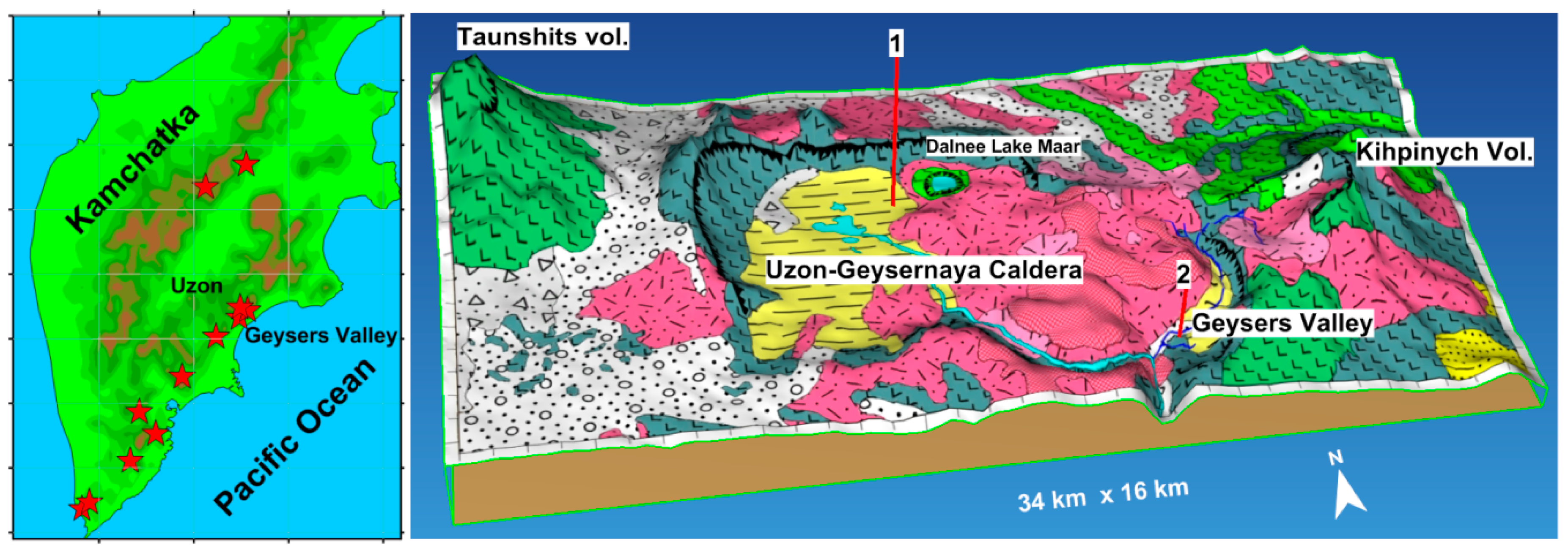
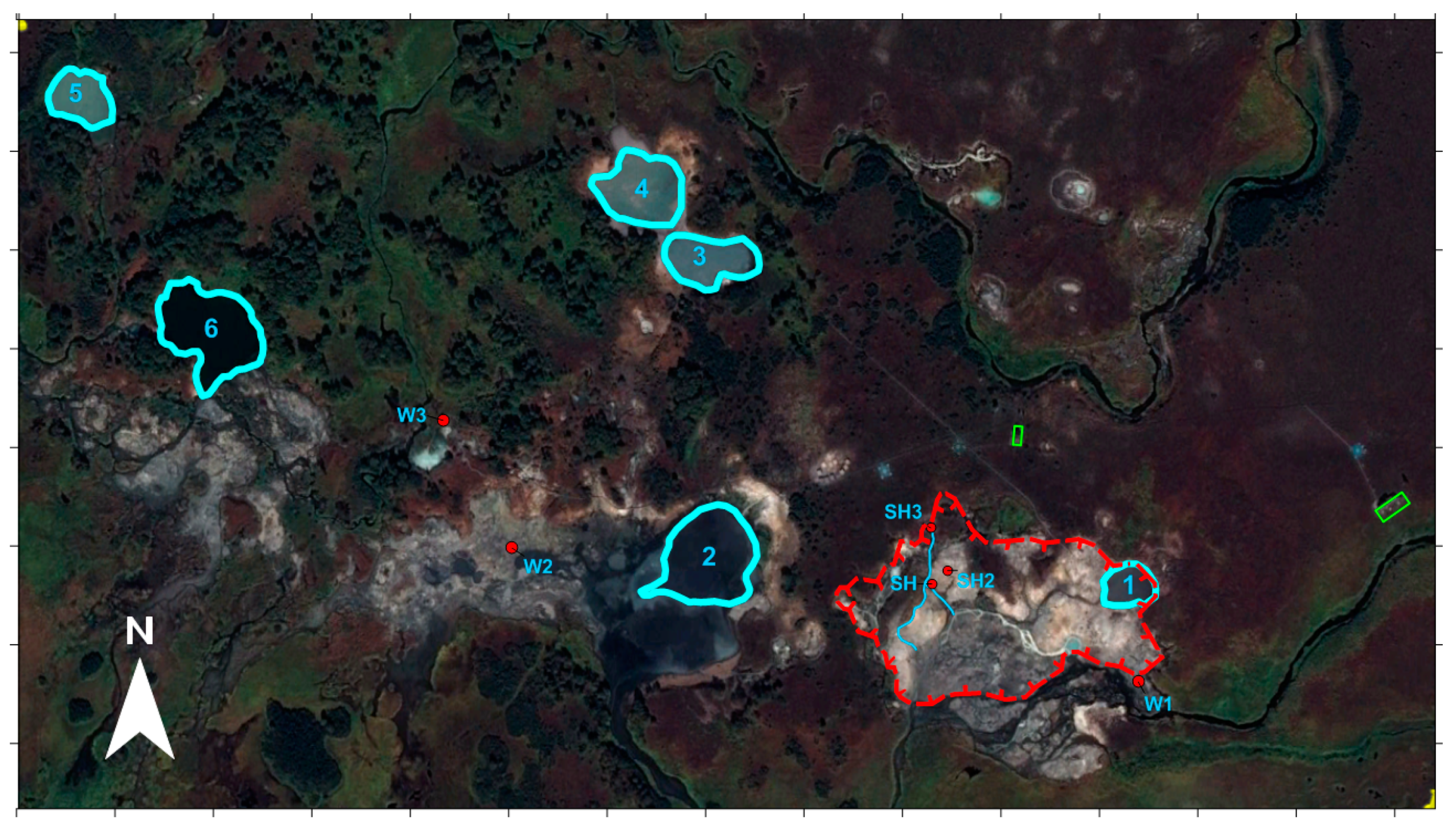
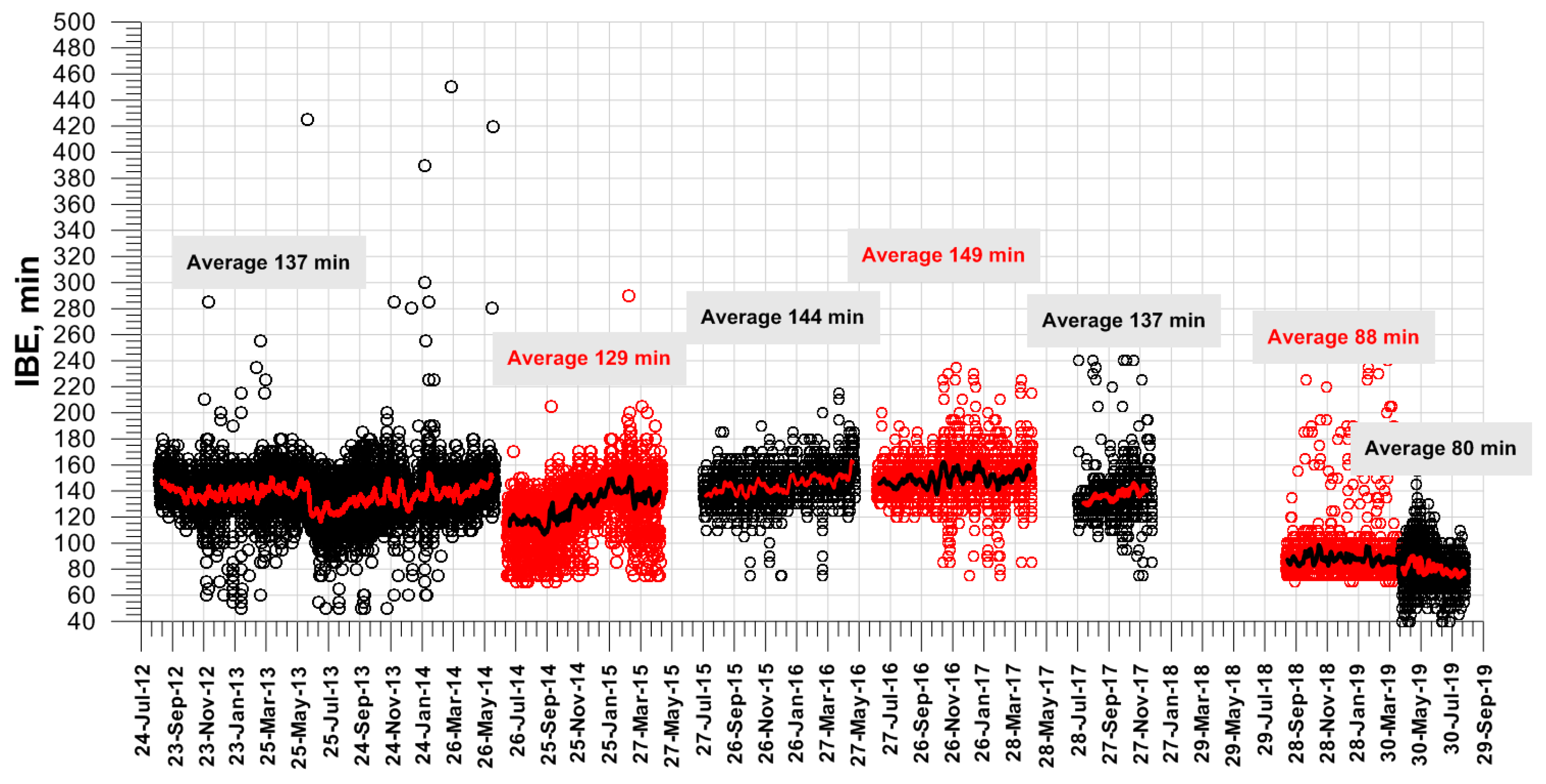
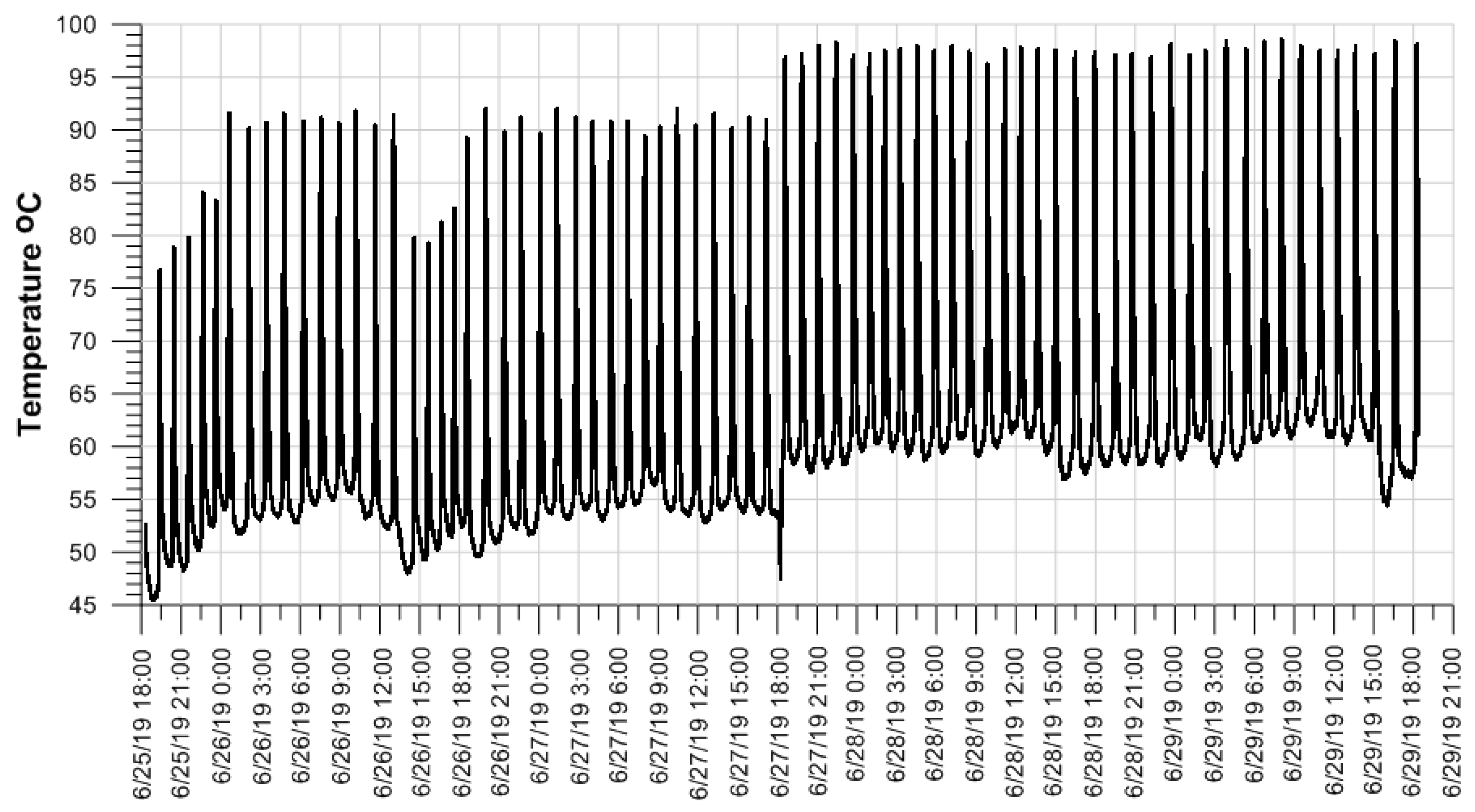
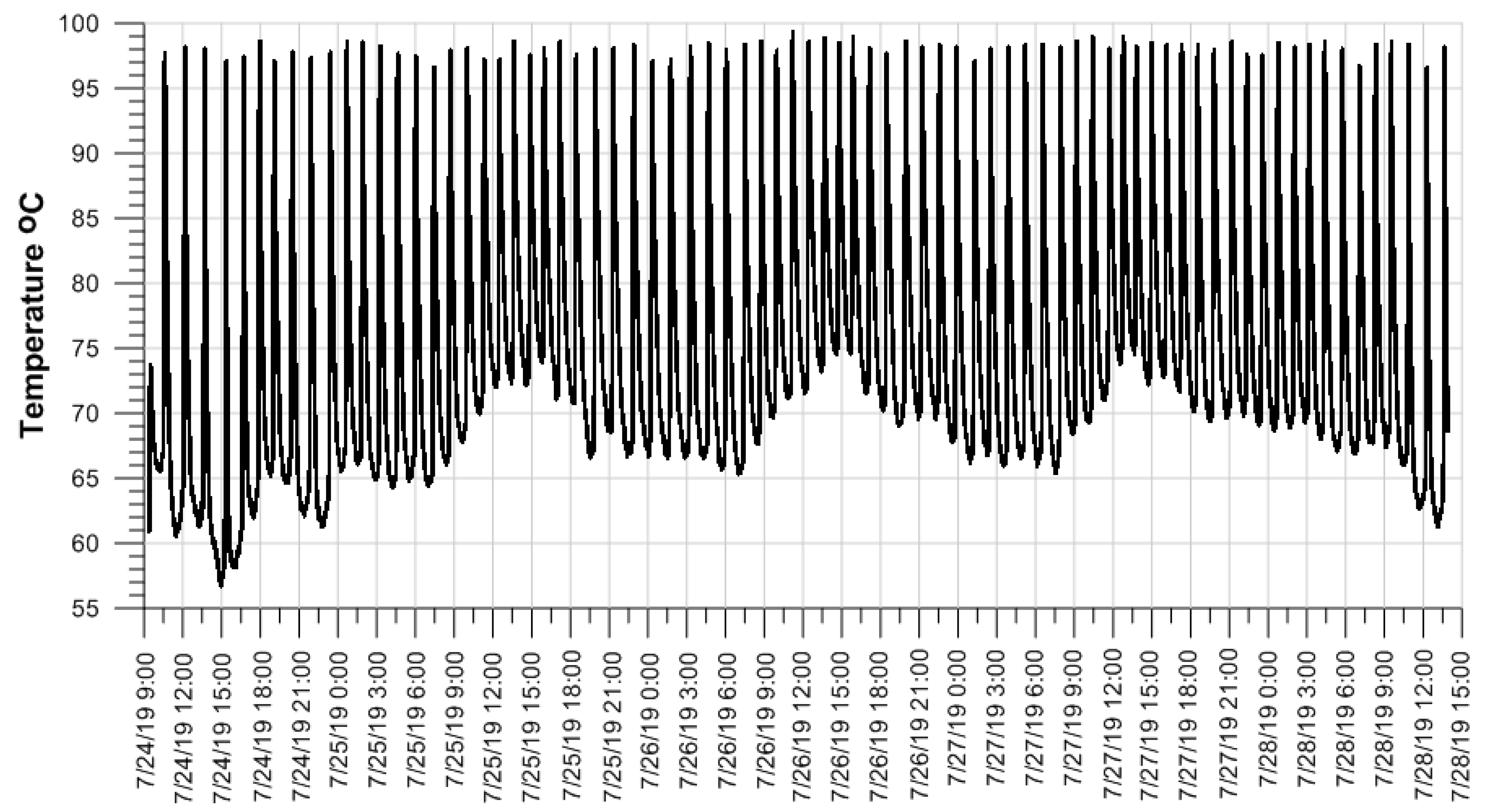
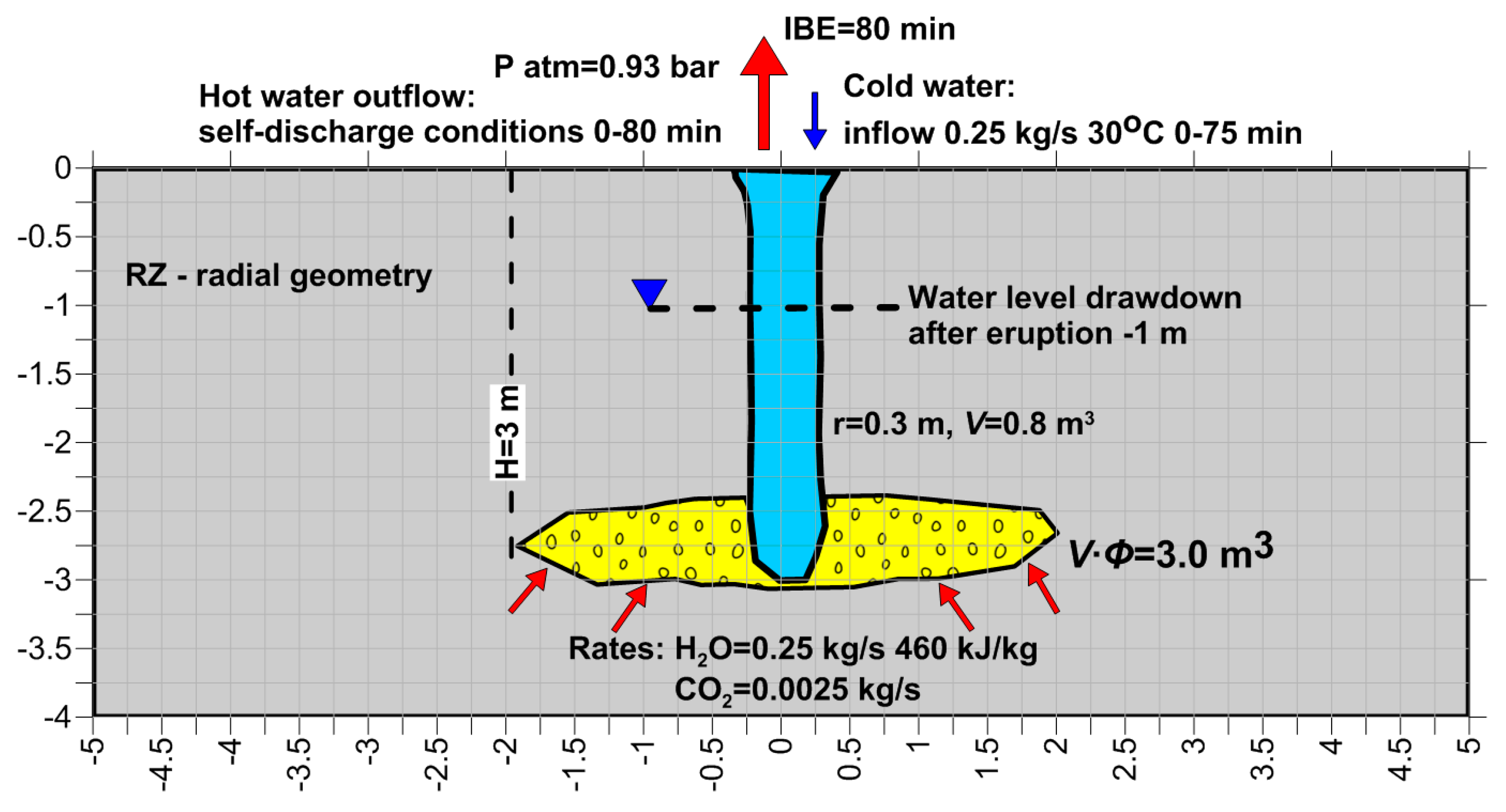
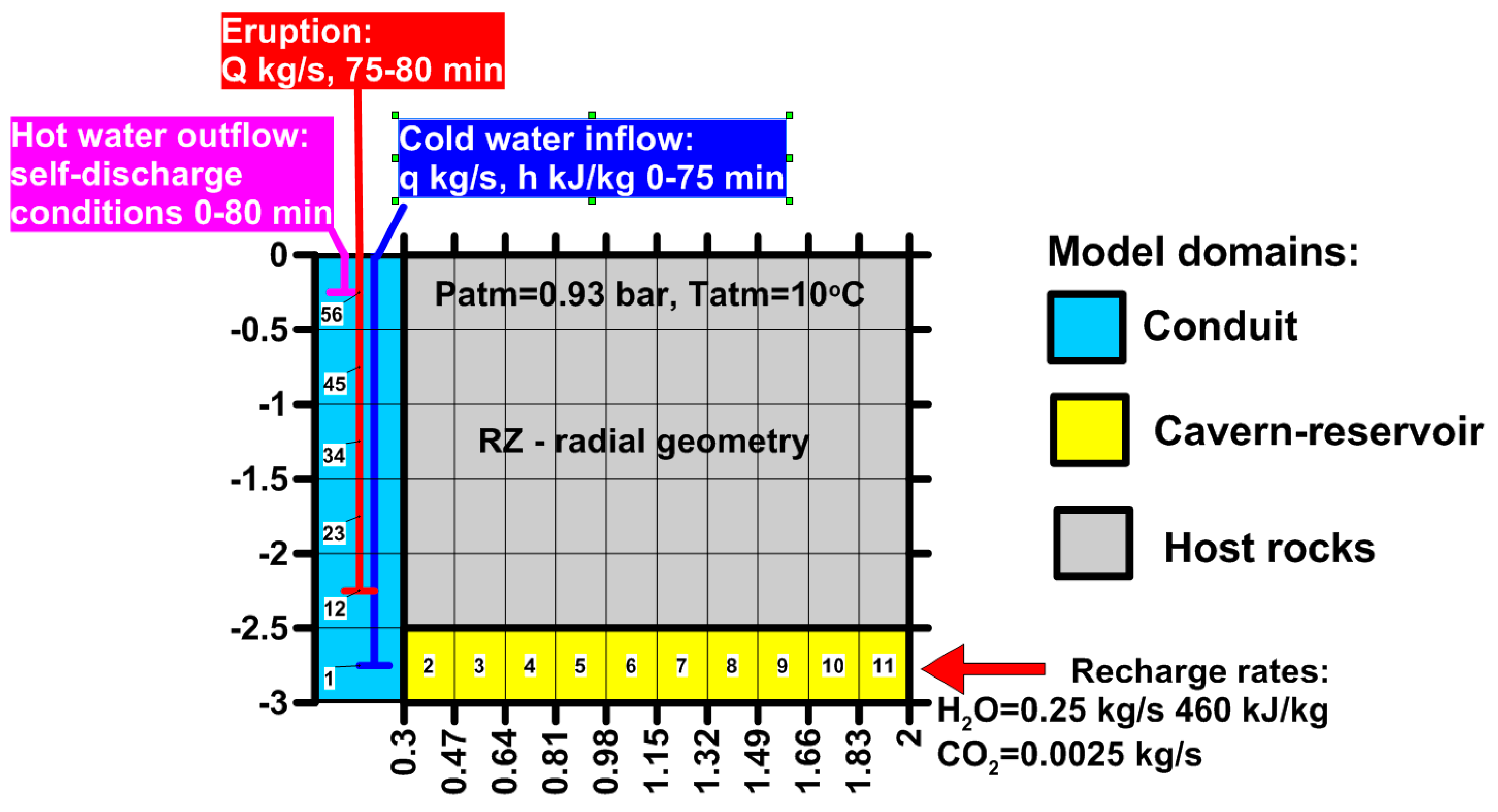
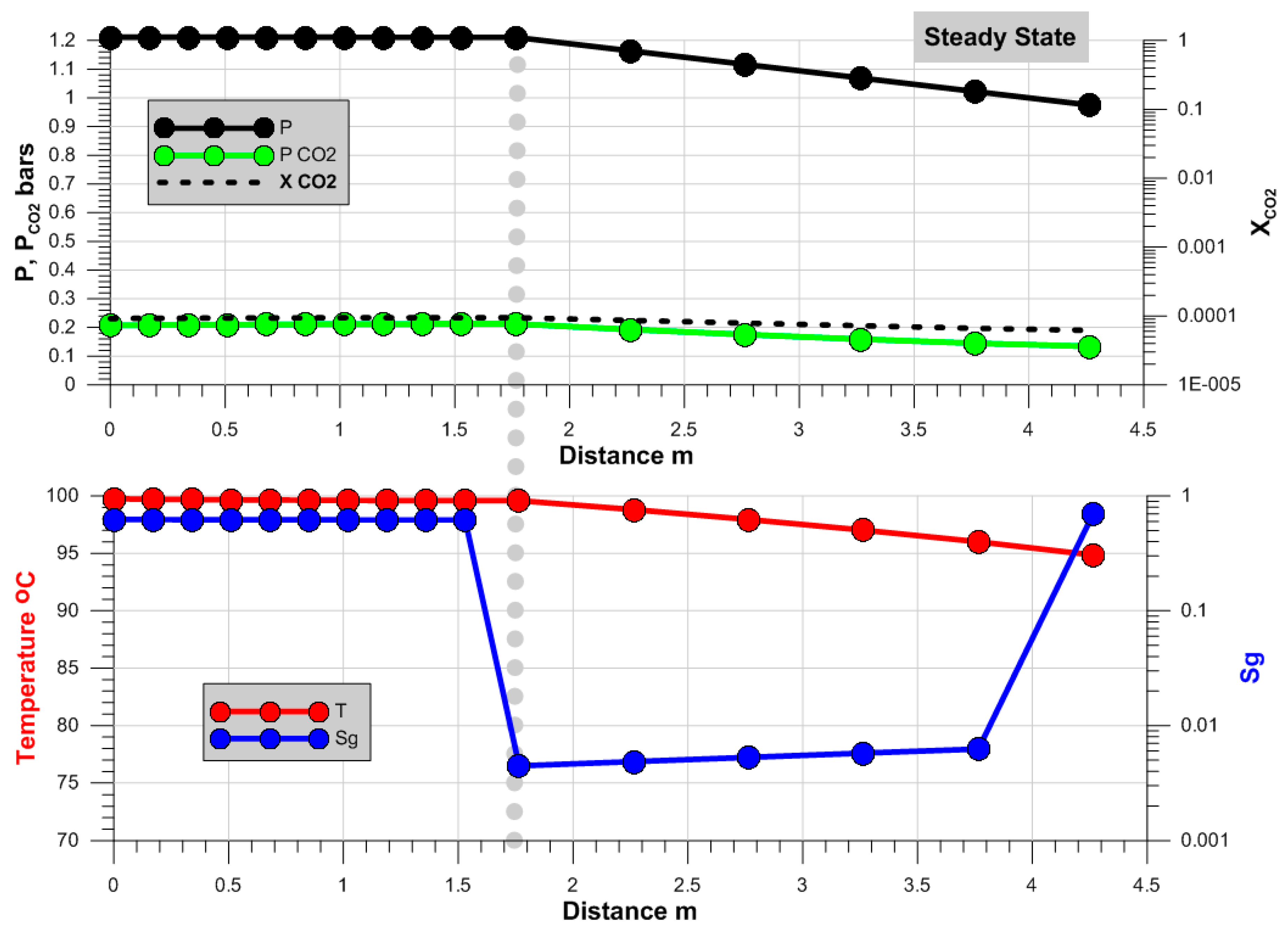
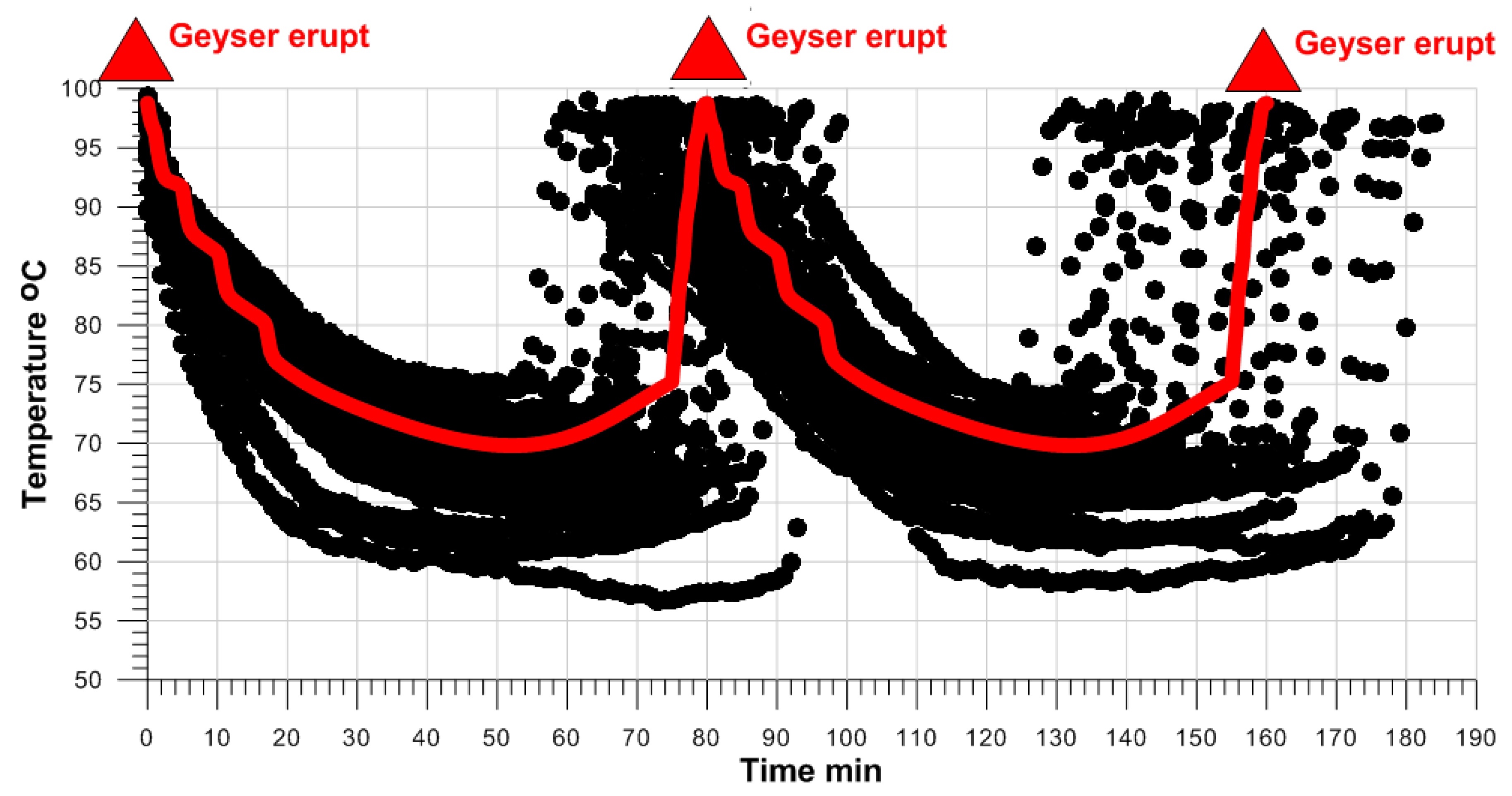
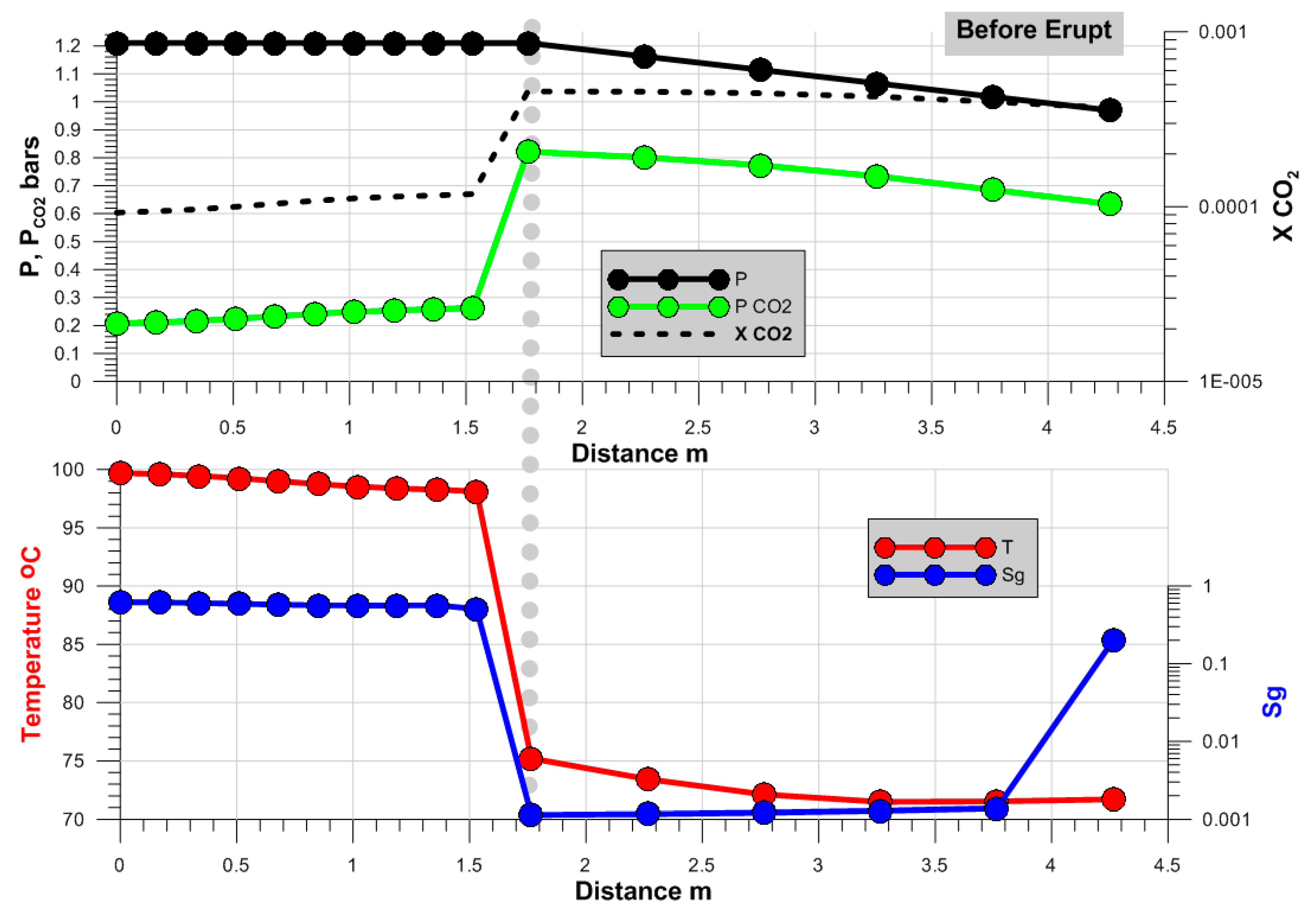
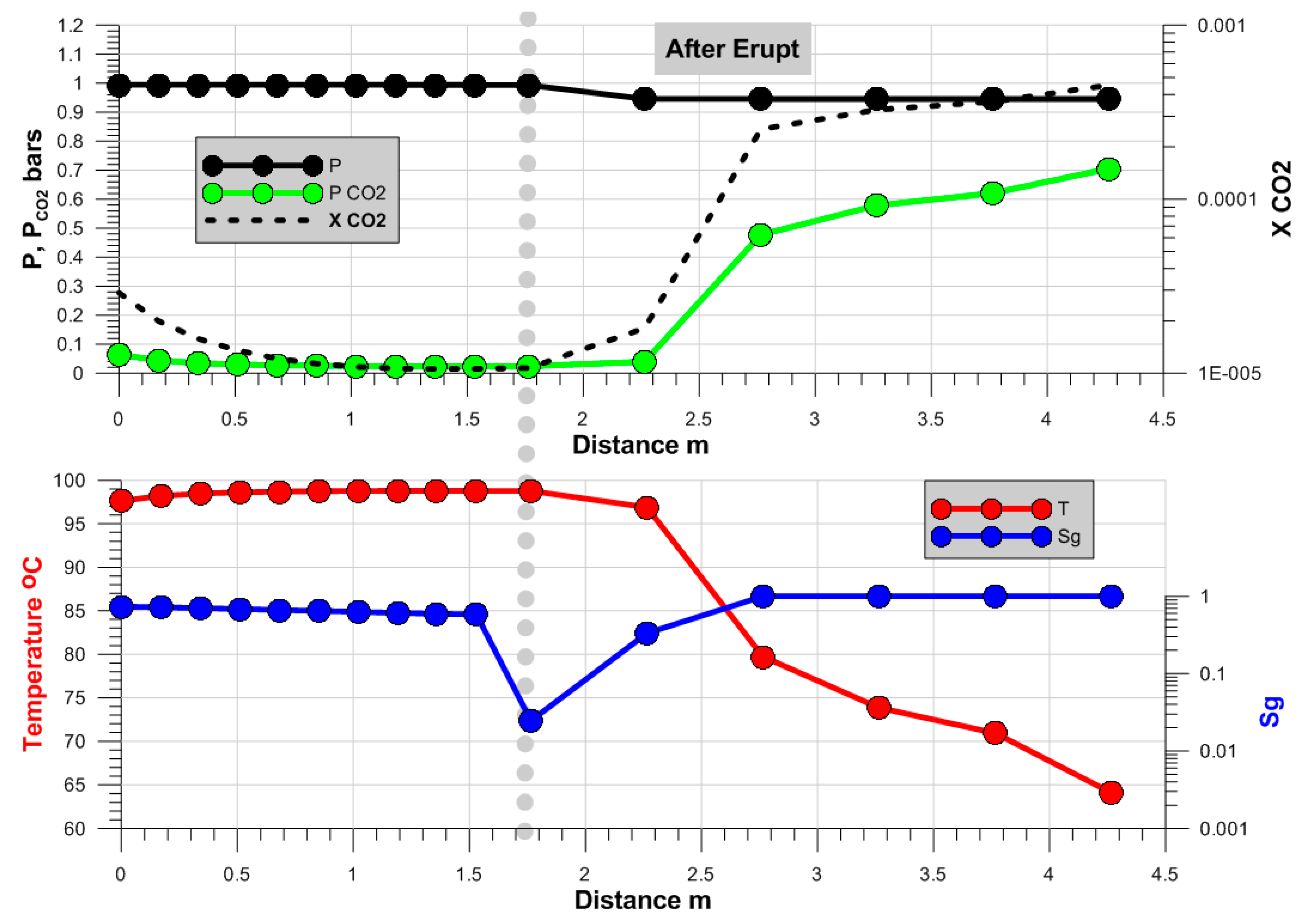
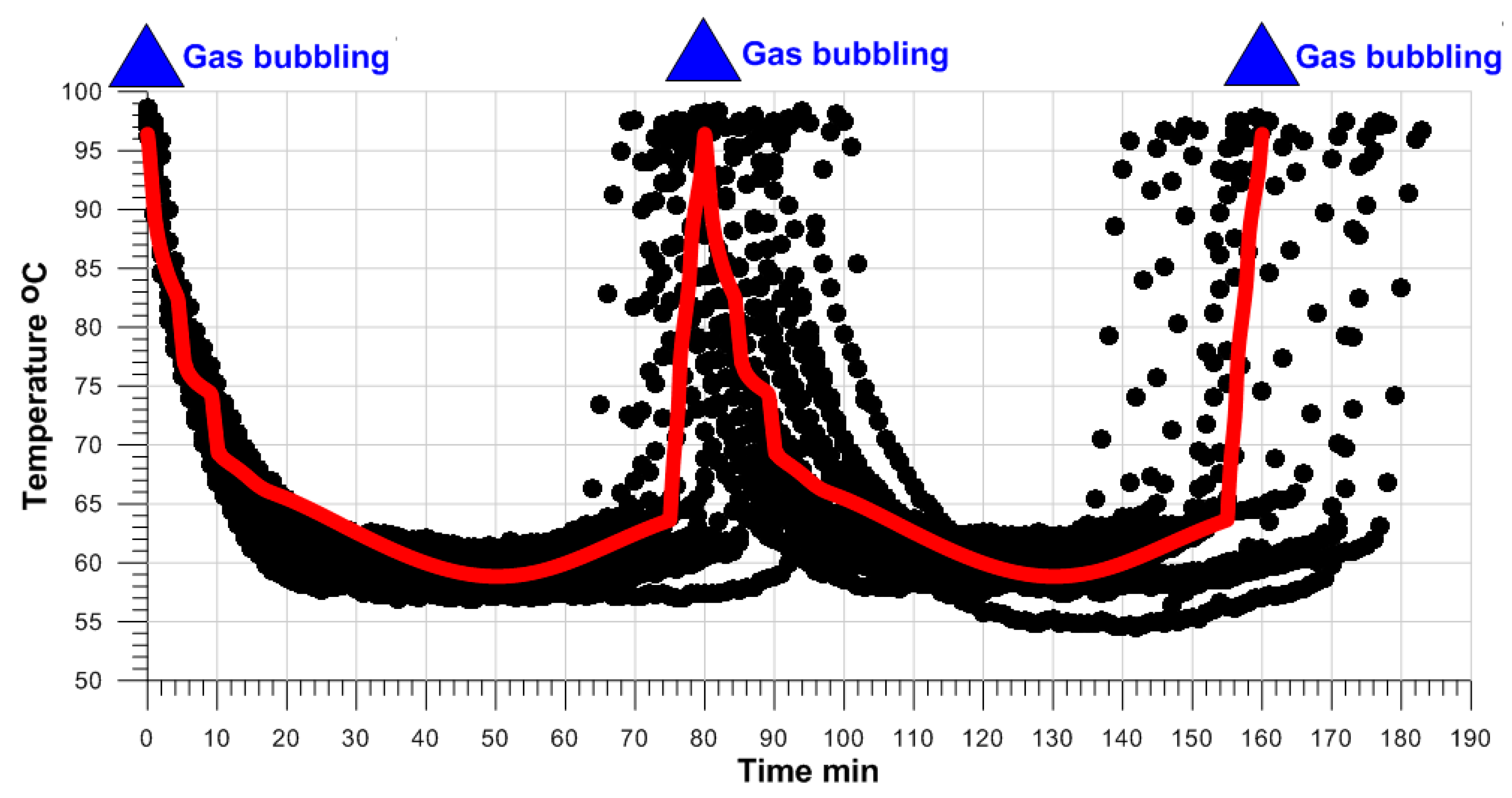
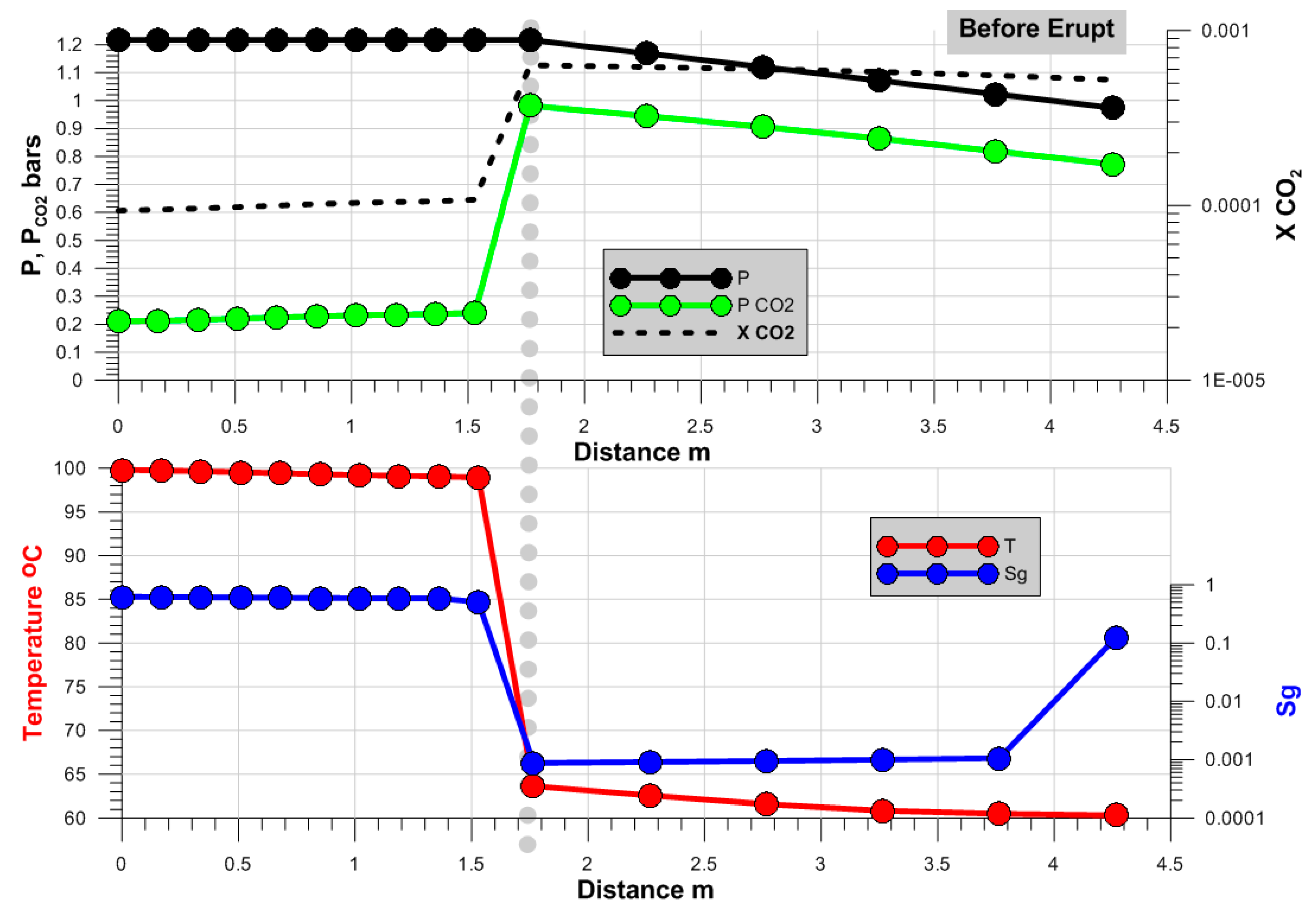
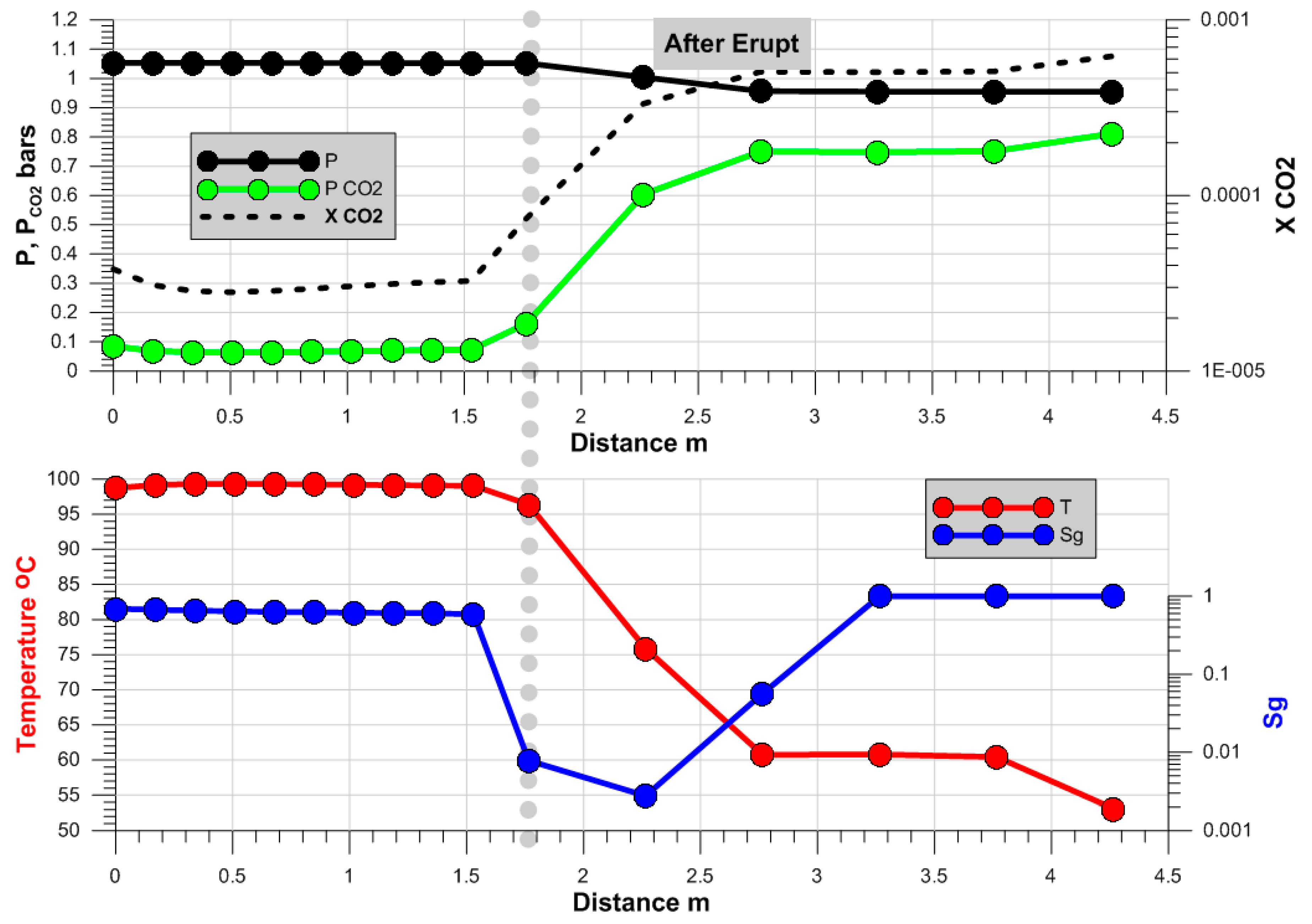
| ## | Data | pH | HCO3 | Cl | SO4 | NH4 | Na | K | Ca | Mg | H3BO3 | SiO2 | TNa-K | TSiO2 | δD ‰ | δ18O ‰ |
|---|---|---|---|---|---|---|---|---|---|---|---|---|---|---|---|---|
| SH | 2006 | 5.2 | 6 | 1365 | 365 | 4 | 859 | 72 | 45 | 0.20 | 366 | 411 | 169.4 | 235.2 | ||
| SH | 2009 | 5.9 | 68 | 1454 | 231 | 3 | 1007 | 61 | 50 | 1.20 | 412 | 472 | 139.3 | 247.2 | ||
| SH | 2009 | 6.9 | 56 | 1418 | 231 | 1 | 941 | 62 | 48 | 2.40 | 408 | 255 | 146.7 | 197.3 | ||
| SH | 27.07.15 | 6.3 | 38 | 837 | 158 | 35 | 491 | 47 | 37 | 4.0 | 228 | 286 | 181.9 | 205.8 | −102.7 | −11.5 |
| SH | 28.07.17 | 6.1 | 55 | 682 | 192 | 15 | 478 | 43 | 10 | 3.3 | 161 | 219 | 176.2 | 186.5 | −105.7 | −12.1 |
| SH | 02.05.18 | 4.7 | 10 | 521 | 221 | 13 | 379 | 23 | 20 | 6.2 | 131 | 204 | 139.8 | 181.4 | −111.9 | −13.5 |
| SH | 02.05.18 | 5.6 | 21 | 695 | 231 | 15 | 493 | 35 | 13 | 5.5 | 176 | 241 | 153.0 | 193.3 | −108.7 | −13.4 |
| SH | 22.04.19 | 3.6 | 425 | 259 | 15 | 308 | 32 | 27 | 4.4 | 176 | 241 | 191.8 | 193.3 | |||
| SH | 24.08.19 | 5.5 | 1 | 532 | 240 | 98 | 298 | 45 | 17 | 4.4 | 219 | 358 | 236.8 | 223.6 | ||
| SH3 | 26.08.19 | 4.4 | 266 | 207 | 4 | 201 | 25 | 32 | 15 | 47 | 394 | 212.4 | 231.5 |
| Geyser | Date | He | H2 | Ar | O2 | N2 | CO2 | CH4 | H2S | δ13C CO2 | δ13C CH4 |
|---|---|---|---|---|---|---|---|---|---|---|---|
| Shaman | 18.09.2009 | 0.0004 | 4.12 | 0.01 | 0.08 | 3.15 | 89.6 | 1.83 | 0.8 | ||
| Shaman | 25.07.2012 | <0.001 | 0.68 | 0.206 | 1.96 | 15.4 | 77.9 | 2.47 | |||
| Shaman | 26.09.2014 | <0.007 | 0.017 | 0.007 | 0.01 | 3.4 | 93.6 | 2.24 | |||
| Shaman | 02.05.2018 | 0.0004 | 0.005 | 0.81 | 17.0 | 70.0 | 12.1 | 0.04 | −6.7 | ||
| Shaman-2 | 02.05.2018 | 0.0003 | 0.23 | 0.66 | 12.6 | 56.2 | 29.2 | 1.05 | |||
| Shaman | 22.04.2019 | 0.0006 | 0.25 | 0.14 | 1.46 | 11.5 | 83.5 | 3.1 | |||
| Shaman | 27.08.2019 | 0.0005 | 0.001 | 0.13 | 0.93 | 10.3 | 86.2 | 2.4 | −3.4 | −22.9 | |
| Shaman-2 | 27.08.2019 | 0.0004 | 0.002 | 0.56 | 10.9 | 52.7 | 34.9 | 1.0 | −15.8 | ||
| Shaman | 05.09.2019 | 0.0004 | 2.03 | 0.014 | 0.83 | 9.83 | 84.1 | 2.4 | −6.76 | −30.4 |
| Model Domain | Rock Min. Density kg/m3 | Porosity | Permeability m2 | Wet Heat Conductivity W/m oC | Specific Heat J/kg oC |
|---|---|---|---|---|---|
| GEYSER CONDUIT | 2600 | 0.99 | 1 × 10−8 | 2 | 1000 |
| CAVERN-RESERVOIR | 2600 | 0.5 | 1 × 10−8 | 2 | 1000 |
| HOST ROCK | 2600 | 0.1 | 1 × 10−17 | 2 | 1000 |
| Before Discharge | After Discharge | CO2 Release in kg | CO2 Release in L | |||
|---|---|---|---|---|---|---|
| Mode | CO2 | H2O | CO2 | H2O | ||
| Steady State | 0.767 | 1842 | 0.767 | 1842 | 0 | 0 |
| Geyser erupt | 1.081 | 2102.3 | 0.650 | 1271.9 | 0.431 | 219.4 |
| Cycling Flowrate | 1.199 | 2084.6 | 0.885 | 1551.7 | 0.314 | 159.9 |
© 2020 by the authors. Licensee MDPI, Basel, Switzerland. This article is an open access article distributed under the terms and conditions of the Creative Commons Attribution (CC BY) license (http://creativecommons.org/licenses/by/4.0/).
Share and Cite
Kiryukhin, A.V.; Karpov, G. A CO2-Driven Gas Lift Mechanism in Geyser Cycling (Uzon Caldera, Kamchatka). Geosciences 2020, 10, 180. https://doi.org/10.3390/geosciences10050180
Kiryukhin AV, Karpov G. A CO2-Driven Gas Lift Mechanism in Geyser Cycling (Uzon Caldera, Kamchatka). Geosciences. 2020; 10(5):180. https://doi.org/10.3390/geosciences10050180
Chicago/Turabian StyleKiryukhin, Alexey V., and Gennady Karpov. 2020. "A CO2-Driven Gas Lift Mechanism in Geyser Cycling (Uzon Caldera, Kamchatka)" Geosciences 10, no. 5: 180. https://doi.org/10.3390/geosciences10050180
APA StyleKiryukhin, A. V., & Karpov, G. (2020). A CO2-Driven Gas Lift Mechanism in Geyser Cycling (Uzon Caldera, Kamchatka). Geosciences, 10(5), 180. https://doi.org/10.3390/geosciences10050180




